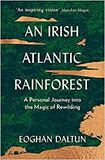
At the midpoint of an Irish Atlantic Rainforest, Eoghan Daltun’s urgent and beautiful description of his life on the Beara peninsula, the author takes stock. Daltun reflects on the power of home: of how, having worked to create a piece of rewilded landscape in a corner of Co Cork, the place now lifts his sense of wellbeing to another level. “From the very beginning,” he writes, “I have felt a powerful and profound sense of fusion with this piece of land and all the life within, and what I have given of myself to it has been returned in spades, and more.”
In the next paragraph, however, Daltun describes the inevitable obverse of this powerful natural energy. The book describes the means by which his 70-acre farm has been enabled to rewild: fenced in to become an ecological island, protected from the grazing creatures that keep the greater part of upland Ireland artificially bald — even though this is a country that, in Daltun’s memorable phrase, “wants to be wooded”. The Beara temperate rainforest that is the result of his labours is a place of wonder, however it is difficult to remain optimistic when beyond the fence the world is burning, and desiccating, and being laid waste.
A frame of historical awareness contextualises the book’s vision against a vast span of human and planetary time
Daltun describes — compellingly, persuasively — how rewilding can work in economic, ecological and political terms. Rewilding rejuvenates impoverished soil. It prevents flooding and fires. It encourages the return of the predators without which ecosystems cannot fully function. It creates networks of sustainable rural jobs. The economics of rewilding, as well as its larger philosophy of healing and reconnecting, are convincing.
Daltun’s arguments, moreover, are held in place by something larger and more systemic; a frame of historical awareness contextualises the book’s vision against a vast span of human and planetary time. It is from this frame that the book derives its impressive power. Daltun notes that the notion of “wild” is a complex term: for example, such fragments of old-growth forest as remain on the Beara have regenerated amid what he calls the “post-apocalyptic landscape” of the Famine. Human and natural histories, in other words, are tightly connected — and it is in this understanding of symbiosis that hope for the future, perhaps, still remains.








